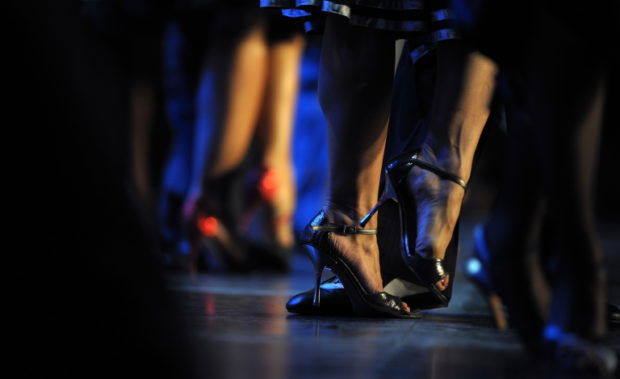Argentina’s tango dancers go solo awaiting embrace lost to pandemic

Dancers perform during the final round of the Tango Salon competition during the VII Tango Dance World Championship in Buenos Aires on Aug. 29, 2009. Image: AFP/Alejandro Pagni
Tango’s once-warm embrace has grown cool under Argentina’s strict coronavirus quarantine, though aficionados are finding a way to circumvent social isolation with virtual classes while they wait for dance venues to reopen.
The lockdown means milongas, traditional dance clubs that dot the Buenos Aires cityscape, are closed indefinitely.
Teachers are maintaining a minimum income from online classes, but they can’t replace the connection that makes the dance so powerful for many.
“The embrace represents 100% of tango,” says Jonathan Villanueva, a teacher at Style and Elegance, a tango academy which is now offering its classes on Facebook. “The essential thing is contact with the other.”
It leaves practitioners of the passionate dance experiencing a unique artistic anguish, tango was never meant to be danced alone.
Article continues after this advertisementBut in some ways, the lack of the embrace, or of a partner to hold, fits with tango’s penchant for nostalgia, absence and melancholy.
Article continues after this advertisementAt 35 and with two decades of dancing behind him, Villanueva is giving online classes for the first time.
“What we are doing with our classes is alleviating the need of people who want to learn,” he says.
From the covered patio of his house in Buenos Aires, he demonstrates the steps and give directions to students that he cannot see.
Chairs are suggested as an imaginary dance partner, and he himself often uses a broomstick to help with posture.
“Without the embrace, there would be no tango. But since we cannot hold each other, we go to the next step, which is technique,” says his 27-year-old dance partner Jorge Vargas, who films the classes. “When we will meet again we will just hold each other and dance.”
Karo Pizzo, author of “Tango Techniques for Women”, also teaches online from her home in Benito Juarez, 400 kilometers (250 miles) southwest of Buenos Aires.
She has students from around the world who are interested in perfecting different technical aspects of the dance.
“At the end of the class, I feel a kind of anguish, I miss dancing,” says Pizzo, 43.
Milonga magic
Like everyone else in Argentina, Carolina Andohanin has been in compulsory isolation since March 20. Before then, she took classes at the Tango Milonguero Academy in the center of Buenos Aires.
Andohanin says she is lucky because she lives with a “milonguero,” another frequenter of the city’s milongas, which allows her to dance despite the quarantine, but it doesn’t compare with going to an actual milonga venue.
“The magic of arriving, meeting your milonguero friends, stepping onto the dance floor, the expectation of ‘who I will dance with?’! With each milonguero, the embrace is different. All that is lost dancing at home,” she says.
For many, the milonga is their only social activity. In these clubs, there is little of the acrobatic hip swiveling and leg flicking that pepper professional tango shows.
Nonetheless, the milongueros dress up for events, and those who dance best are coveted partners.
“He who dances well, no matter what age or appearance, is like Brad Pitt,” said Nora Roncal, a once-regular milonga-goer who laments that the quarantine interrupted her recent return to the dance floor after a two-year lapse.
“The only hope is that the coronavirus vaccine will appear. Without that there is no room for tango, because tango is the embrace. It is being body-to-body and face-to-face with a stranger.”
Roncal isn’t much taken by the idea of online classes. But home alone one night, she put on her high-heels and dressed up as if to go out. She put on some tango music and, like so many now, danced alone.
Slow return
The dancers look anxiously to the future.
“Tango is taking a break now during the quarantine. We have to see when and how we are going to resume. For independent teachers, it’s very traumatic not to know when we are going to return to work and our normal life,” said Villanueva.
Jorge Doallo has been dancing regularly for nearly 25 years. He shares the quarantine days in his apartment in the Buenos Aires neighborhood of Belgrano with his partner Perla.
They continue to practice their steps, even if they are not quite sure what awaits them in the future milongas of a much-changed world.
“After the pandemic, there are going to be certain resentments felt in the milongas,” said Doallo, 63. “I suppose people are going to have to adopt an open embrace and not a closed one as most like it.”
Getting back to normal will be “slow, very, very slow.” JB
RELATED STORIES:
WATCH: Fitness trainer leads group workout from rooftop during COVID-19 lockdown
Running free across Paris in lockdown
After winning 10 gold medals, dancesport athletes deserve a second look
For more news about the novel coronavirus click here.
What you need to know about Coronavirus.
For more information on COVID-19, call the DOH Hotline: (02) 86517800 local 1149/1150.
The Inquirer Foundation supports our healthcare frontliners and is still accepting cash donations to be deposited at Banco de Oro (BDO) current account #007960018860 or donate through PayMaya using this link.